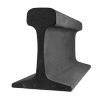Note: Photos show the three different road numbers. See product description for road number information.
Features:
RP25 wheels
Silky-smooth & powerful PIKO Mechanism for great low-speeds and precise running
Period-specific details
PIKO knuckle couplers
DC / DCC Sound Version
A Little About The Prototype...
Krauss-Maffei of Germany worked closely with the Southern Pacific and the Denver & Rio Grande to develop a revolutionary new diesel-hydraulic locomotive. At the start of the 1960s, these beasts packed 4000 horsepower, a feat that would not be matched by American Diesel locomotive builders for many years. Typical American diesels of the time had only 2000 HP or less. The idea of replacing two locos with one in mainline service had great appeal. The hydraulic transmissions were an effort to eliminate the complexity and maintenance issues of electrical traction motors and all their related controls.
Three “Prototype” locos were delivered to SP in 1961 and three to D&RGW. These cab locos with their rounded noses and full carbodies looked very different than the slightly larger batch of “Series” hood locos later delivered to the SP. Upon delivery, both roads promptly put their KMs to work in the hardest possible service, with dynamometer cars often following to test every aspect. Performance was impressive, but teething problems quickly developed. German technicians sent over to the SP and D&RGW worked to address issues and train local maintenance crews. Over time, many modifications were made and reliability improved, but in the end, the locos may simply have been victims of a difference of cultures. Technology that was commonplace and successful in European railroads just did not mesh well with American railroad operation and maintenance practices. None of the six “Prototype” locos survived the decade, but they made an indelible mark with many thousands of fans.
The original SP Prototype locos started life as almost identical triplets. But modifications over the years made them quite different. Now numbered 9100, 9101, and 9102, these faithful replicas show each loco in its mid-60s weathered and battle-scarred appearance, with numerous detail differences, such as:
• Side air intake louvers & upper intake shutters
• Filter boxes and rooftop vents
• Roof-mounted EMD air reservoirs with additional piping
• EMD-style pilot snowplows
• Exposed exhausts with butterfly valve flaps
• Each loco features accurate – and different – SP ‘wing’ patterns on the noses. (See the image for nose comparisons of the three Prototypes.)
• Different paint patches and revised road number stenciling
• ‘Pre-weathered’ paint colors authentically reflect years of sun-fading and partial repainting
Prototype photo used.






